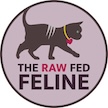Happy Earth Day!
While everyday should be earth day, today is the official day that we take some time to reflect on how we impact our planet. So let’s think about our cats’ impact and what we can do about it.
Cats have a carbon footprint just like we do. A carbon footprint is the total amount of greenhouse gases caused by our actions. For cats, this is primarily related to their diet. On average, house cats produce approximately 310 kg of carbon dioxide per year. The majority of cats’ carbon footprint is related to their diet.
Diet
The more meat that is consumed by an individual, the higher the carbon footprint. Since cats are obligate carnivores, eating meat cannot be avoided. Cats CANNOT eat a plant based diet or participate in Meatless Mondays, like we can (hint, hint).
The larger the animal and more resources that they use, the higher the carbon footprint. This means that beef is the meat that contributes the most greenhouse gases.
The first thing you can do to minimize your cat’s diet related carbon footprint is to feed beef less frequently in your cat’s rotation. You can make beef more of a special occasion meat rather than a frequent item on your cat’s menu.
Another option is to feed grass fed, pasture raised, or organic beef. These options are better for the planet as less chemicals/pesticides are used, although the issues in terms of land and water usage remain.
Smaller animals have smaller carbon footprints, so sheep, goats, pigs, chickens, turkeys, ducks, rabbits, etc., will all have smaller carbon footprints than beef cattle.
Since feeding smaller animals helps minimize the negative impact on the planet, I’m going to make a plug for feeding some whole prey. Whole prey animals are very small and have minimal carbon footprints. Just think about the size difference between a cow and a mouse!
Incorporating some whole prey in your cat’s diet is a very environmentally friendly way to feed your cat.

Toys
Another way to be a more planet friendly cat parent is to make your cat’s toys from things you already have at home rather than buying new ones or ones made from plastic. Repurpose items that you can use to play with your cat. Cats don’t really need anything fancy, they just want something that moves like prey. An old t-shirt can be cut into strips to pull along the floor or a balled up piece of paper can be batted around, for example.
According to cats worldwide, boxes are the best repurposed item ever! You can turn them over and cut a hole in the side to make a fun hidey hole that your cat can pounce out of during playtime. Or put some old blankets or towels in the bottom of a box for a DIY cat bed. You can even use several boxes to make a whole structure for them to explore.
Hiding some treats in a balled up towel or eggshell carton is another fun DIY activity for your cat. Bringing some of nature inside can be an enriching activity, too. Sticks, rocks, leaves, etc. all have wonderful smells for cats to explore.
Dishes & containers
It’s best to avoid plastic food and water dishes in general because they harbor bacteria. But they are also not good for the planet since they end up in landfills. Stainless steel and glass dishes are better options as they last a long time and can be recycled.
Buying dishes second hand is a good way to use already existing items. If you follow the.raw.fed.feline on Instagram, you know that I love finding small plates at my local thrift store for Hazel’s food!
Using glass containers for storing raw food is another planet friendly choice to consider. The more you can minimize using single use plastic, the better. Glass canning jars that are freezer safe are a nice option for raw food. Glass doesn’t retain smells, cleans easily, lasts a long time, and is recyclable.
Litter
I recommend using a stainless steel litter box. Plastic boxes get scratched up, retain smells, and have to be thrown out periodically, contributing to landfill waste. Stainless steel boxes are super easy to clean and last forever. They cost more at the outset, but since they last, they are actually a better deal over time. The same can be said of litter scoopers. Metal ones will last much longer than plastic ones do, which keeps them out of landfills.

When it comes to litter, cat parents tend to have some pretty strong feelings! Finding a litter that works for your cat and situation is important. It is better for the planet to use a clumping litter. Clumping litter does not require full litter box changes as frequently as non-clumping litters do, which means less litter in landfills overall.
Many cat parents use clay litter because of its price point and convenience. Plus, it works really well. However, from an environmental standpoint, clay litter is one of the worst options. It is not biodegradable and requires extensive mining to extract from the ground. Many tons of clay litter sit in landfills.
Silica litter is another popular option that is not environmentally friendly. It is not biodegradable and contributes to landfill waste as clay does.
better options for the planet
Clumping litters that are made from a renewable and biodegradable resource are the better choice for the planet. Grass based, walnut shell, tofu, corn, and wheat are some of the more environmentally responsible options available. However, these litters tend to cost more than clay litter. One thing you can do is to use half and half to minimize the impact on your wallet, while also minimizing the use of clay litter. It doesn’t have to be all or nothing, every action helps.
Recycled paper is another option that is planet friendly, but not really that great as a litter, in my opinion.
When introducing a new litter, you want to go slow and give your cat time to adjust to the litter. Pretty much like when you introduce a new food. Start with a small amount of the new litter with the old litter and gradually increase the amount of new over time, until you are using 100% of the new litter. You don’t want to rush this process and run the risk of your cat avoiding the litter box.
How you dispose of litter is another consideration. It is not advised to flush cat waste and litter. But bagging up your biodegradable litter in a plastic bag that does not degrade doesn’t make much sense. Using biodegradable bags, like the ones made for picking up dogs’ poo, is an environmentally friendly way to dispose of your cat’s litter waste.
I have links to litter items on my Resources page, which can be found here.

So, there you have it! Some of my thoughts on how to be a more environmentally responsible cat parent on this Earth Day 2024. What are some of the ways that you care for the planet while caring for your cat?


